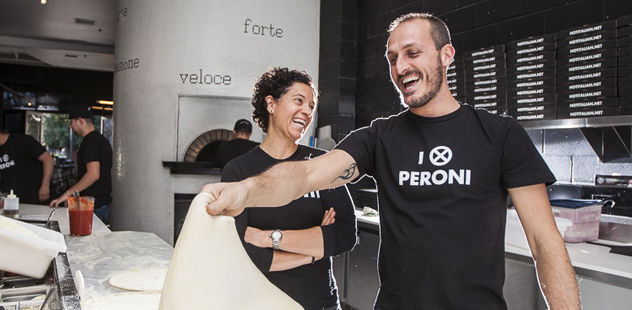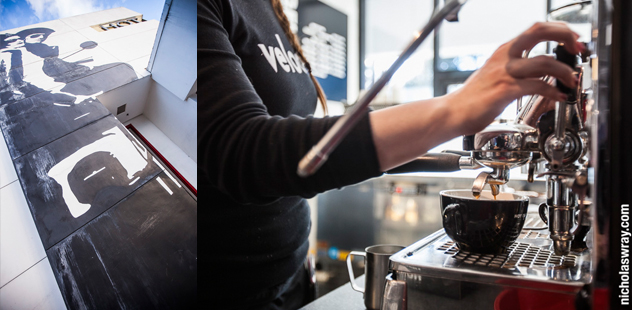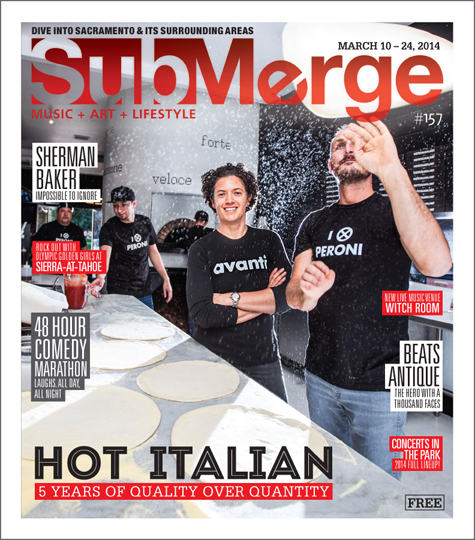 Photos by Nicholas Wray
Photos by Nicholas Wray
Hot Italian co-owners Andrea Lepore and Fabrizio Cercatore reflect on five years in business
On their fifth anniversary, Hot Italian owners Fabrizio Cercatore and Andrea Lepore celebrated simultaneously with Sacramento Beer Week. Hot Italian, as many who have frequented its immense, black and white dining room must by this point know, is the combination of modernist, Italian aesthetic and locally sourced, Californian quality. It is the Old World delicacy made modern in the best state of the West. It is fitting, therefore, that for Beer Week, Hot Italian brought in Birra Peroni from Italy and Sierra Nevada Brewing Company from Northern California, and showcased their pizza-centric acumen with local cheeses and The Center for Land Based Learning, a non-profit that focuses on educating and growing the next generation of farmers here in the Sacramento Valley.
Hot Italian wants to pay homage to its longstanding love affair with the two Mediterranean climates, one seaside, one landlocked. Cercatore learned the restaurant trade in La Spezia, a small province on the west side of the Italian peninsula. As the owner of a restaurant and bed and breakfast, he came to realize his love of cooking all things Italian, but most importantly pizza.
In the early aughts, Cercatore met Andrea Lepore, a second-generation Italian-American ready to make a leap from sports business into the restaurant industry, and together they decided to give Sacramento something it had largely been missing—straight, simple, Italian pizza.
In building their new restaurant, Cercatore and Lepore caught the rising wave of green construction and design. They fused this together with the renovation of a longstanding retail and warehouse space. The building was gutted, and the new pieces were fitted together with a conscious decision to minimize the restaurant’s carbon footprint. At the time, Hot Italian was celebrated as one of the first LEED businesses in Sacramento.
While the New York Times has since canceled its Green Business blog, and the ambitions of a green business revolution have been checked by economic turbulence and the “realities” of international trade, the owners of Hot Italian continue to think green. Their tradition of thinking locally first is evident in their recent Responsible Epicurean and Agricultural Leadership (REAL) certification, a national initiative that looks to promote quality ingredients that are locally sourced, fair trade and non-GMO. The idea is, if the stuff we put into our food is healthy, we should be healthy too. This premise, as Cercatore and Lepore highlight, is the basis for the quality of Hot Italian’s eats, and had been long before national certifications started encouraging food businesses to consider their customers’ well beings before the bottom line.
In short, Hot Italian has been filling the bellies of its patrons, in both Sacramento and Emeryville, Calif., for the last few years. The pizza, salads, and calzones are as simple as the business plan itself: Do something consistently and well while utilizing the plethora of local ingredients available to our region. If the crowds over the weekend are any indicator—the lunch service was still packed at 2 p.m.—Cercatore and Lepore are doing simple, and doing it quite well.
Tell me about your first experience here in Sacramento. What did you think of the city?
Fabrizio Cercatore: I was stuck for six days in Elk Grove, in August, and I tried to walk. I almost died.
Andrea Lepore: I took him to Midtown immediately. There’s things to do here!
Tell us about the Leadership in Energy and Environmental Design (LEED) Certificate. Why did you decide to go green when you were building the restaurant?
AL: We were the first LEED restaurant. There were other buildings, but they were government buildings. It was the first public building that was LEED certified, that you could just walk into…This was a cold shell. It was retail and a warehouse. Basically everything was new: new storefront, new roof, new plumbing, new electrical, new sidewalks. When you have to do that much work, you might as well build it green if you’re going to rebuild something.
Why did you decide on a modernist design?
AL: When we designed this place in 2007, even when we traveled, there weren’t many Italian places that were modern. A few in LA, a handful in New York. We want to celebrate Italian design. We’ve paired that with local Californian design. Mike Wilson, who’s a local furniture maker, has built a lot of the furniture pieces here. I think it’s an intelligent way to design. It’s very functional. It’s not ornate like French Country. Good modern design is designed to be functional. We wanted this place to be warm. A lot of people think of modern as steel and hard edges. We wanted to combine elements.
FC: I like modern design for its simplicity. I like when modern is combined with the natural elements: wood, iron, stone, marble.
Tell me about the REAL certification.
FC: Technically, we didn’t do anything. They showed up, and said, “You need to do that.” And we said, “We already have that, have that, have that.” It was really simple. It helps that we have a lot of combinations with vegetables and pizza. It’s one of their points: eat more vegetables. It helps that we’re in California.
AL: They send a nutritionist and a certification person to the restaurant and check how you source your ingredients. They make sure that things aren’t processed, that the ingredients are local, sustainable, that there aren’t GMOs…If people aren’t buying local here, then where are they buying from? I was in Boston; I went to the market, and it was all stuff from California. We are, I guess, the farm-to-fork capital.
Why has Hot Italian been so successful? How have you made it to your five-year anniversary?
AL: It’s a simple concept. The quality has been there since day one. We’re not gonna do pasta, or osso buco, or have a huge menu. If you want pizza, we want you to come here.
FC: I think people really like the consistency and the quality. The quality is in the food and in the brand. In the beginning the quality might look expensive, but it’s in the meal. We had a new kind of pizza here, in Sacramento. People were used to really thick crust and a lot of cheese. It was more about quantity and not about quality. People responded well [to our pizza]. We have a smart customer.
What we do is real Italian style. There’s a lot of pizza around, but we keep the Italian way. Not a lot of chicken or pineapple. If you want to experience real Italian pizza, you can come here [to Hot Italian] or you can buy a plane flight and go 11 hours that way [pointing east].
AL: It’s a lot cheaper, eating here.
Some restaurants only care about good food, others care about ambiance. What’s the focus for Hot Italian?
FC: We want to give an experience to the customer. The experience is not just in the food but it’s also in the environment. That’s why we have the modern look. When you talk about an Italian restaurant it’s the old Tuscany style, with the red and white table cloths.
AL: We really wanted it to be just like in Italy, a community gathering place, where people come and have an espresso, or stay and meet friends. We wanted to have that same feel. With pizza being such a communal food, it’s the sort of perfect platform for this concept.
What’s your best memory from the last five years?
FC: Before we opened there was a lot of work we did to raise money, when Hot Italian was just an idea. I remember I was putting together events and making everything at Andrea’s house, preparing all the ingredients. Then going to investors’ houses and making pizza in their own ovens. It was crazy. They were like, “How did you make that in my house?” The moment we opened, people understood it, Hot Italian and the concept.
One time we did this big event at the airport. Our first big event as Hot Italian. We made 100 pizzas. We didn’t have enough refrigeration. I was trying to figure out where to store the dough. We had to ask our friends, neighbors.
AL: Bella Bru actually stored the dough for us in their large walk-in.
What’s the big difference between Italy and the United States?
FC: Weeks ago, two of my good friends came to visit me from Italy. I hadn’t seen them in so long, and they stayed for three weeks. They reminded me how my life was in Italy. We were laughing all day, sometimes about stupid things, but we were laughing all day. We were happy, you know. Enjoying the little things of daily life, and I’ve kind of lost that. It’s a different way, easy to get lost in. You forget about that. They reminded me that I’m Italian.
We have a lot of defects in Italy; we are a mess, a beautiful mess. We have nothing. But we have food, we have the family, we have each other and then there’s the next day.
If you haven’t visited Hot Italian in the past five years, where the heck have you been? It’s located at 1627 16th Street in Sacramento.




Comments